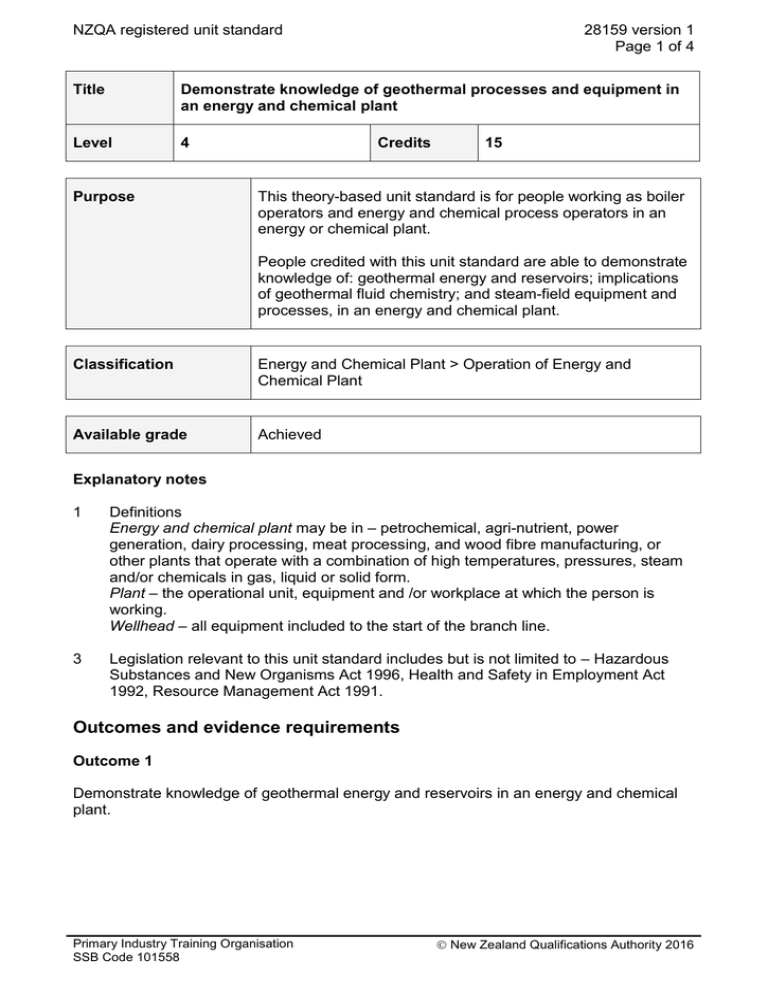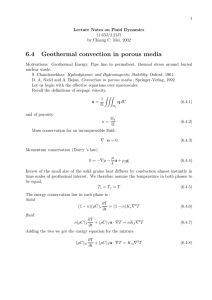NZQA registered unit standard 28159 version 1 Page 1 of 4
advertisement

NZQA registered unit standard 28159 version 1 Page 1 of 4 Title Demonstrate knowledge of geothermal processes and equipment in an energy and chemical plant Level 4 Purpose Credits 15 This theory-based unit standard is for people working as boiler operators and energy and chemical process operators in an energy or chemical plant. People credited with this unit standard are able to demonstrate knowledge of: geothermal energy and reservoirs; implications of geothermal fluid chemistry; and steam-field equipment and processes, in an energy and chemical plant. Classification Energy and Chemical Plant > Operation of Energy and Chemical Plant Available grade Achieved Explanatory notes 1 Definitions Energy and chemical plant may be in – petrochemical, agri-nutrient, power generation, dairy processing, meat processing, and wood fibre manufacturing, or other plants that operate with a combination of high temperatures, pressures, steam and/or chemicals in gas, liquid or solid form. Plant – the operational unit, equipment and /or workplace at which the person is working. Wellhead – all equipment included to the start of the branch line. 3 Legislation relevant to this unit standard includes but is not limited to – Hazardous Substances and New Organisms Act 1996, Health and Safety in Employment Act 1992, Resource Management Act 1991. Outcomes and evidence requirements Outcome 1 Demonstrate knowledge of geothermal energy and reservoirs in an energy and chemical plant. Primary Industry Training Organisation SSB Code 101558 New Zealand Qualifications Authority 2016 NZQA registered unit standard 28159 version 1 Page 2 of 4 Evidence requirements 1.1 Geothermal reservoirs are described in terms of their characteristics. Range 1.2 Geothermal steam at a plant is described in terms of its thermodynamic characteristics. Range 1.3 characteristics include but are not limited to – feed zone, cold inflow, permeability, resistivity, reinjection return. thermodynamic characteristics include but are not limited to – temperature phases, pressure, enthalpy. The extraction of energy from geothermal wells is described in terms of plant data. Range data includes but is not limited to – total energy content, well pressure, ratio of steam to water, well depth, well temperature, flow rates, well output curves. 1.4 Techniques used to optimise the mechanical equipment of geothermal wells at a geothermal plant are described in terms of best performance. 1.5 Reinjection, management of ponds, and discharges to water and land are described in terms of operating requirements. 1.6 Causes of problems experienced with geothermal wells are identified and described in terms of their effects. Range problems include but are not limited to – subsidence, cold water infiltration, slug flow, deposition, formation, well casing fractures, rock permeability, energy output. Outcome 2 Demonstrate knowledge of the implications of geothermal fluid chemistry for an energy and chemical plant. Evidence requirements 2.1 Geothermal fluids at a plant are described in terms of chemical components and health and safety implications. Range 2.2 geothermal fluids include but are not limited to – water, non condensable gases, dissolved gases, dissolved solids, suspended solids, heavy metals. Hazards arising from geothermal fluid components are identified and described in terms of their controls. Range hazards include but are not limited to – hydrogen sulphide (H2S) hazard, as gas build up in low lying areas and well cellars, H2S Primary Industry Training Organisation SSB Code 101558 New Zealand Qualifications Authority 2016 NZQA registered unit standard 28159 version 1 Page 3 of 4 cap build up in shut in wells, venting of H2S cap; carbon dioxide (CO2); heavy metals in pipe work and vessel depositions. 2.3 Precautions to protect steam-field and power station equipment from geothermal fluid chemistry and thermodynamic properties are described in terms of the actions required. Range precautions include but are not limited to – steam and/or water delivery chemistry limits, scrubbing pipelines, separators, separator wash water, scrubbers, acid dosing of produced/separated/reinjected water. Outcome 3 Describe steam-field equipment and processes in an energy and chemical plant. Evidence requirements 3.1 Steam-field wellhead equipment is described in terms of its design. Range 3.2 Steam-field wellhead equipment is described in terms of its operation. Range 3.3 pipe work includes but is not limited to – lagging, drains, steam traps, expansion control, valve types, orifice plate, pressure relief, pipeline anchoring, pipeline expansion, pipeline low points, two phase fluid pipeline requirements, multiple well connection to single pipelines. Plant steam field separation equipment is described in terms of its design and operating concepts. Range 3.5 operation includes but is not limited to – shut in well shut monitoring, placing on bleed, controlled warm up, killing the well, down hole well monitoring and measurement. Steam-field pipe work and fittings are described in terms of their design and operating concepts. Range 3.4 equipment includes but is not limited to – casing, cellar, support structure, isolation valve. plant separation equipment may include but is not limited to – separators, separator wash water, scrubbers, water vessels and accumulators, silencers, pressure reducing stations, steam vent stations; evidence is required of two different pieces of equipment. Plant steam-field control and protection systems are described in terms of their design and operating concepts. Range plant steam-field control and protections systems may include but are not limited to – separator level protection, scrubber level Primary Industry Training Organisation SSB Code 101558 New Zealand Qualifications Authority 2016 NZQA registered unit standard 28159 version 1 Page 4 of 4 protection, pipeline drain pot protection, pressure relief equipment, reinjection low/ reverse flow, dump station activation, pond level alarming; evidence is required of two different systems. Replacement information This unit standard and unit standard 28160 replaced unit standard 17607. Planned review date 31 December 2019 Status information and last date for assessment for superseded versions Process Version Date Last Date for Assessment Registration 1 24 October 2014 N/A Consent and Moderation Requirements (CMR) reference 0079 This CMR can be accessed at http://www.nzqa.govt.nz/framework/search/index.do. Please note Providers must be granted consent to assess against standards (accredited) by NZQA, before they can report credits from assessment against unit standards or deliver courses of study leading to that assessment. Industry Training Organisations must be granted consent to assess against standards by NZQA before they can register credits from assessment against unit standards. Providers and Industry Training Organisations, which have been granted consent and which are assessing against unit standards must engage with the moderation system that applies to those standards. Requirements for consent to assess and an outline of the moderation system that applies to this standard are outlined in the Consent and Moderation Requirements (CMR). The CMR also includes useful information about special requirements for organisations wishing to develop education and training programmes, such as minimum qualifications for tutors and assessors, and special resource requirements. Comments on this unit standard Please contact the Primary Industry Training Organisation standards@primaryito.ac.nz if you wish to suggest changes to the content of this unit standard. Primary Industry Training Organisation SSB Code 101558 New Zealand Qualifications Authority 2016






